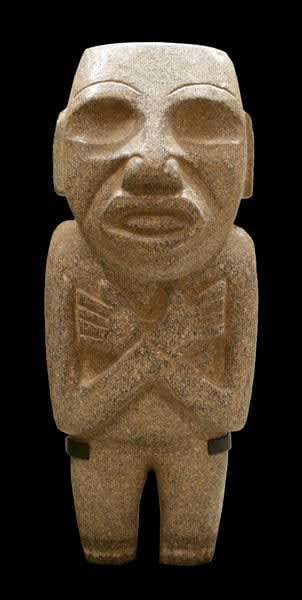Aztec Stone Idol, 1350 CE - 1550 CE
Stone
7 x 17.5
CK.0091
The Aztec civilization is perhaps the most celebrated of the ancient Mesoamerican cultures. Their empire stretched throughout northern Mexico and was surpassed in size only by that of the Incans....
The Aztec civilization is perhaps the most celebrated of the ancient Mesoamerican cultures. Their empire stretched throughout northern Mexico and was surpassed in size only by that of the Incans. Tenochtitlan (modern-day Mexico City) was the center of their religious and political systems. The city was composed of a group of island located in the center of Lake Texcoco, earning it the nickname “Venice of the New World.” By the time the Spanish Conquistadors arrived in the early 16th Century, led by the infamous Hernan Cortes, Tenochtitlan was by far larger than any city they could have seen in Europe. Today, the Aztec are remembered for their grand temple complex ruins, for their intricate calendar system, and for the few examples of their art that survive today. Aztec art was primarily ecclesiastical and is renowned for its powerful nature. Highly adept at working with stone, the Aztec artists created artworks that were both grand in scale, as evidenced in their temple architecture, and relatively small in size. Like many cultures, the Aztecs believed that many animals had supernatural symbolic associations. Therefore, although the Aztec gods were usually visualized in human form, most gods also had animal aspects. Moreover, it was believed that both men and gods could, at certain times, actually change themselves into powerful animals.
This stone sculpture depicts a standing man holding his arms crossed against his chest. His head is enlarged when contrasted to the size of his body. He has large, hollowed out eyes that give him a skeletal appearance. It is possible that these eye sockets would have been inlaid with shell or colored stones in order to suggest actual eyes. His open mouth recall the shape of mouth from Olmec sculpture, revealing the influence that this ancient culture continued to have on subsequent Mesoamerican civilizations long after their demise.
This stone sculpture depicts a standing man holding his arms crossed against his chest. His head is enlarged when contrasted to the size of his body. He has large, hollowed out eyes that give him a skeletal appearance. It is possible that these eye sockets would have been inlaid with shell or colored stones in order to suggest actual eyes. His open mouth recall the shape of mouth from Olmec sculpture, revealing the influence that this ancient culture continued to have on subsequent Mesoamerican civilizations long after their demise.
